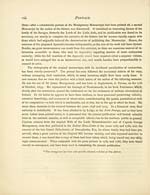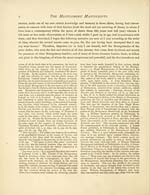Montgomery manuscripts
(15) [Page 1] - First Viscount Montgomery of the Great Ards
Download files
Complete book:
Individual page:
Thumbnail gallery: Grid view | List view
![(15) [Page 1] - First Viscount Montgomery of the Great Ards](https://deriv.nls.uk/dcn17/9523/95233109.17.jpg)
The Montgomery Manuscripts:
SOME FEW MEMOIRES OF THE MONTGOMERIES 2 OF IRELAND.
CHAPTER I.
EING to write of the Montgomeries of Ireland (now planted therein), recourse must be
first had to what I have credibly heard, as truth never doubted of (that my enquiry could
find out). And secondly, to those authentick papers and parchments, which I have care-
fully perused, and which came to my hands among those left to me by my father, many others of
them being lost or embeazled, or burnt in Rosemount House ;3 out of the remainder whereof, or
from such as I have seen elsewhere, relations shall be made. Thirdly, and lastly, I must, in this
1 Manuscripts. — On the title-page of the volume printed
in 1830, it is stated that the Manuscripts contain "me-
moirs of the first, second, and third viscounts Mont-
gomery." There are memoirs of the first, third, and fourth
viscounts ; but we have no notice of the second viscount,
excepting a brief reference to his marriage, which occurs in
the memoir of his father, and an equally short announce-
ment of his death in the memoir of his son, the third vis-
count, who was created first earl of Mountalexander. The
memoir of the second viscount is probably lost, which is
the more to be regretted, as its details were, no doubt,
ample, the author having been both his nephew and
son-in-law. In a MS. copy of the author's Incidentall
Remembrances of the Two Ancient Family s of the
Savadges, he refers to page 92 of his memoir of the
second viscount. In the first edition, the memoir of sir
James Montgomery, of Rosemount, has been introduced
after that of the first viscount, although it was intended
by the author to succeed that of the fourth viscount,
or second earl of Mountalexander.
It is also stated on the title-page that the author, William
Montgomery, was "second son of sir James Montgomery."
Although sir James was thrice married, the author was
his only son — indeed his only surviving child. His
first wife, Catherine, who died in 1634, was a daughter
of sir William Stewart, of Tyrone. In her Funeral Entry,
it is stated that " she had issue by the said sir James one
son, named William, of the age of 18 months." Sir
James Montgomery's second lady was Margaret, eldest
daughter of sir William Cole, of Enniskillen ; and his
third was Francesse St. Laurence, third daughter of
Nicholas, twenty-third baron Howth. The inscription
on the monument erected by William Montgomery, in
Greyabbey, to his father's memory, refers to these ladies
in the following terms, which show that they had left
no children: — "His (sir James's) other two virtuous
ladies and their children (which died before them) lie
buried over against this monument." The author, who
wrote this inscription, which is now quite defaced, de-
scribes himself as primi vcnlris sola proles. — Harris, An-
ticnt and Present State of the County of Down, p. 51.
2 Montgomeries. — This surname is here so written accord-
ing to a modernised orthography adopted in the first edi-
tion, from the commencement of the volume to page 169.
In the original manuscript, however, the plural form of
the surname was invariably written Montgomerys, a spell-
ing from which the author never appears to have deviated.
In such of his manuscripts as are still preserved, the sur-
name is always Montgomery in the singular number, and
Montgomerys in the plural. In a letter of the author to
his kinsman, William Montgomery, of Gransheogh, dated
November, 1 701, he says : — "I wold have your son
take notice, that our sirname, in ye pattents of our family,
and in ye acts of parliament, both of England and Ire-
land, and in all printed books, historys, and others, in
our three kingdoms, (wch I can show you,) is spelled as
I subscribe it, as divers gentlemen of estate doe, and as
the count Montgomery, in Normandy, did, and yet doth,
as I have prooved in a paper I wrot to that purpose, and
concerning ye rectifying of y e subscription of sirnames ;
of wch many persons have heedlessly taken upon custom to
write them ye wrong way, w ch imports an ignorance occa-
sioned by carelessness. " In the text we have the simple but
comprehensive title prefixed by the author to his Manuscripts.
3 Rosemount House. — Rosemount is the name invariably
used by the author to designate the family residence ad-
joining Greyabbey. In the form of Mountross it is so
applied in the year 1634, as appears from the Funeral
Entry of Katherine Stewart (sir James Montgomery's first
lady), already quoted in a preceding note. On the 20th
of April, 1629, the first viscount Montgomery granted
lands at Greyabbey to his second son, sir James; but the
name Rosemount is not mentioned in this grant. On the
19th March, 1 638, sir James received a grant from the
SOME FEW MEMOIRES OF THE MONTGOMERIES 2 OF IRELAND.
CHAPTER I.
EING to write of the Montgomeries of Ireland (now planted therein), recourse must be
first had to what I have credibly heard, as truth never doubted of (that my enquiry could
find out). And secondly, to those authentick papers and parchments, which I have care-
fully perused, and which came to my hands among those left to me by my father, many others of
them being lost or embeazled, or burnt in Rosemount House ;3 out of the remainder whereof, or
from such as I have seen elsewhere, relations shall be made. Thirdly, and lastly, I must, in this
1 Manuscripts. — On the title-page of the volume printed
in 1830, it is stated that the Manuscripts contain "me-
moirs of the first, second, and third viscounts Mont-
gomery." There are memoirs of the first, third, and fourth
viscounts ; but we have no notice of the second viscount,
excepting a brief reference to his marriage, which occurs in
the memoir of his father, and an equally short announce-
ment of his death in the memoir of his son, the third vis-
count, who was created first earl of Mountalexander. The
memoir of the second viscount is probably lost, which is
the more to be regretted, as its details were, no doubt,
ample, the author having been both his nephew and
son-in-law. In a MS. copy of the author's Incidentall
Remembrances of the Two Ancient Family s of the
Savadges, he refers to page 92 of his memoir of the
second viscount. In the first edition, the memoir of sir
James Montgomery, of Rosemount, has been introduced
after that of the first viscount, although it was intended
by the author to succeed that of the fourth viscount,
or second earl of Mountalexander.
It is also stated on the title-page that the author, William
Montgomery, was "second son of sir James Montgomery."
Although sir James was thrice married, the author was
his only son — indeed his only surviving child. His
first wife, Catherine, who died in 1634, was a daughter
of sir William Stewart, of Tyrone. In her Funeral Entry,
it is stated that " she had issue by the said sir James one
son, named William, of the age of 18 months." Sir
James Montgomery's second lady was Margaret, eldest
daughter of sir William Cole, of Enniskillen ; and his
third was Francesse St. Laurence, third daughter of
Nicholas, twenty-third baron Howth. The inscription
on the monument erected by William Montgomery, in
Greyabbey, to his father's memory, refers to these ladies
in the following terms, which show that they had left
no children: — "His (sir James's) other two virtuous
ladies and their children (which died before them) lie
buried over against this monument." The author, who
wrote this inscription, which is now quite defaced, de-
scribes himself as primi vcnlris sola proles. — Harris, An-
ticnt and Present State of the County of Down, p. 51.
2 Montgomeries. — This surname is here so written accord-
ing to a modernised orthography adopted in the first edi-
tion, from the commencement of the volume to page 169.
In the original manuscript, however, the plural form of
the surname was invariably written Montgomerys, a spell-
ing from which the author never appears to have deviated.
In such of his manuscripts as are still preserved, the sur-
name is always Montgomery in the singular number, and
Montgomerys in the plural. In a letter of the author to
his kinsman, William Montgomery, of Gransheogh, dated
November, 1 701, he says : — "I wold have your son
take notice, that our sirname, in ye pattents of our family,
and in ye acts of parliament, both of England and Ire-
land, and in all printed books, historys, and others, in
our three kingdoms, (wch I can show you,) is spelled as
I subscribe it, as divers gentlemen of estate doe, and as
the count Montgomery, in Normandy, did, and yet doth,
as I have prooved in a paper I wrot to that purpose, and
concerning ye rectifying of y e subscription of sirnames ;
of wch many persons have heedlessly taken upon custom to
write them ye wrong way, w ch imports an ignorance occa-
sioned by carelessness. " In the text we have the simple but
comprehensive title prefixed by the author to his Manuscripts.
3 Rosemount House. — Rosemount is the name invariably
used by the author to designate the family residence ad-
joining Greyabbey. In the form of Mountross it is so
applied in the year 1634, as appears from the Funeral
Entry of Katherine Stewart (sir James Montgomery's first
lady), already quoted in a preceding note. On the 20th
of April, 1629, the first viscount Montgomery granted
lands at Greyabbey to his second son, sir James; but the
name Rosemount is not mentioned in this grant. On the
19th March, 1 638, sir James received a grant from the
Set display mode to:
![]() Universal Viewer |
Universal Viewer | ![]() Mirador |
Large image | Transcription
Mirador |
Large image | Transcription
Images and transcriptions on this page, including medium image downloads, may be used under the Creative Commons Attribution 4.0 International Licence unless otherwise stated. ![]()
| Histories of Scottish families > Montgomery manuscripts > (15) [Page 1] - First Viscount Montgomery of the Great Ards |
|---|
| Permanent URL | https://digital.nls.uk/95233107 |
|---|
| Description | A selection of almost 400 printed items relating to the history of Scottish families, mostly dating from the 19th and early 20th centuries. Includes memoirs, genealogies and clan histories, with a few produced by emigrant families. The earliest family history goes back to AD 916. |
|---|

